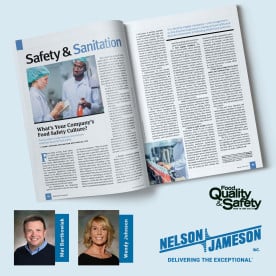Today is Earth Day, and our blog usually focuses around Nelson-Jameson’s social and environmental sustainability practices. This year, however, we’re taking a “big picture” approach, and exploring the overall food industry’s sustainability outlook. We’ll take a closer look at the ways in which food manufacturers, distributors, suppliers and retailers are taking steps to increase sustainability and reduce waste in the supply chain.
 So, what is sustainability? Well, in this context it means that a business’s industrial practices and strategies create and maintain the conditions under which humans and nature can exist in productive harmony while permitting the fulfillment of social and economic needs of present and future generations. For the food industry, sustainability is a major strategic issue for the entire food supply chain---agriculture, manufacturing, packing and distribution. With an expected 60% increase in global food demand by the year 2050, the food industry is facing increasing pressure regarding raw materials, ingredient sourcing and food production in a competitive environment of constant supply chain optimization and control. Given the circumstances, achieving sustainable practices seems pretty daunting. So, what can be done?
So, what is sustainability? Well, in this context it means that a business’s industrial practices and strategies create and maintain the conditions under which humans and nature can exist in productive harmony while permitting the fulfillment of social and economic needs of present and future generations. For the food industry, sustainability is a major strategic issue for the entire food supply chain---agriculture, manufacturing, packing and distribution. With an expected 60% increase in global food demand by the year 2050, the food industry is facing increasing pressure regarding raw materials, ingredient sourcing and food production in a competitive environment of constant supply chain optimization and control. Given the circumstances, achieving sustainable practices seems pretty daunting. So, what can be done?
One of the largest and most popular initiatives involves focusing on food waste. Food waste is food that is discarded or unusable, and it occurs at all levels of the supply chain. An estimated 40% of all food produced in the United States is never eaten. General food waste solutions focus on three overall strategies---Reduce, Recover and Recycle. Food waste can be reduced by improving product development, storage, packaging, procurement, marketing, labeling and cooking methods. It can be recovered by connecting potential food donors (food service providers, food retailers and food processors) to hunger-relief organizations. Finally, food waste can be recycled to feed animals or to create compost, bioenergy and natural fertilizers. In addition to the positive environmental and social implications, managing and reducing food waste is also advantageous to the food industry’s overall financial health. Food waste is estimated to cost the commercial food service industry in the US approximately $100 billion per year, US consumers approximately $43 billion per year and global food processors approximately $750 billion per year.
Another way in which the food industry is increasing sustainability is through strengthening the links between industry and agriculture. Agribusiness is said to build sustainable food systems by providing more nutritious, healthy and foods and assuring increased food security. Many food manufacturers are reevaluating their ingredient and raw material sourcing, and are finding that building direct relationships with local agribusiness is efficient from both a cost and energy standpoint.
Using environmentally-responsible packaging is another example of a strategy in which many sustainably-minded members of the food industry are engaging. Americans recycle at only an average rate of 34.5%, so the majority of food packaging ends up in landfills or as street litter. Therefore, there’s a general perception that the onus to reduce packaging waste and increase recycling is on the makers of packaged foods and beverages. Although packaging only makes up a small part of a product’s environmental impact, packaging heavily influences buying decisions---especially those of sustainably-minded consumers. Therefore, many manufacturers are seeking ways to reduce plastic and paper waste in their packaging, while finding ways to make it easier for consumers to recycle, reuse or compost that packaging.
Consumers are also getting in on the sustainability action. One of the hottest trends in the food industry---eating and buying “local”---is largely consumer-driven. Consumers are finding that locally produced or grown foods are not only beneficial for their local economies, but often fresher, more nutritious and less expensive. And because locally-sourced food travels shorter distances to your dinner plate, less energy and resources are used for processing, packaging, storage and transportation. Many in the food industry are heralding the demand for local foods (especially produce) to be the foundation for future sustainable food and energy practices.
While the food industry is improving their overall social and environmental sustainability practices, there’s still room for improvement. However, the innovation and the will are there, and the benefits are increasingly advantageous for all involved. Thus, many in the food supply chain have realized that it’s critical for the industry to assume responsibility in assuring that the foods and beverages enjoyed by consumers are nutritious, safe and environmentally sustainable.





